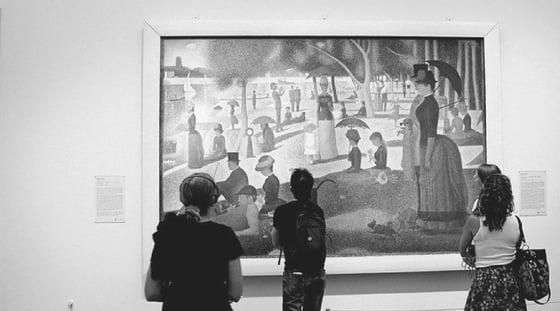


Adding an inbound attitude to your art gallery marketing strategy




Inbound marketing for art galleries isn't easy to perfect. However, we’d like to share a bit of age-old wisdom: “You were born with two ears and one mouth for a reason.”
If Art Gallery Marketing interests you then you can find out more by clicking here...
When it comes to marketing your art gallery, it can be worthwhile remembering this mantra. While it can be tempting to shout about all your fantastic exhibitions, artists and events, it’s even more important that you listen to what your audience is saying.
This is what inbound marketing is all about. By learning about prospective customers’ wants, needs, interests and habits, you can better target your inbound marketing strategy.
Inbound marketing for art galleries and museums
Big data – huge sets of information which can be analysed to reveal a variety of trends – is transforming the way we look at the world. Most importantly, big data can revolutionise the way we interact with each other, and the way businesses interact with their customers.
For retailers, this could mean targeting buyers of folic acid supplements with discount vouchers for nappies. Back in 2012, US retail giant Target determined a teenage girl was pregnant before any of her family did, thanks to data analysis.
When it comes to inbound marketing for art galleries, things are a little different. You can’t just go around emailing visitors offers to buy a Picasso. However, by collecting and analysing the right information, you can better understand your audience and attract them to your gallery.
A beacon of inbound hope
Now for the latest tech. Apple’s iBeacon technology tracks smartphone users and makes it possible to interact with them via Bluetooth transmitters, or beacons. Retail companies can use this technology to track store visitor demographics and share tailored discount offers.
iBeacon also has the potential to inform your art gallery marketing strategy. Artsy discussed how visitor tracking can reveal gallery ‘heat maps’, showing popular routes and dwell times around exhibitions. This data could reveal which installations your visitors enjoy most and which spots see the least footfall, influencing how exhibitions evolve in line with visitor experience.

Art gallery marketing and social media
If a tree falls in a forest and no one hears it, does it make a noise?
We don’t know, we’re not tree surgeons. Our point, though, is that you need to be listening in the right places for the right kinds of noises if you want to gather any useful information.
Now, we love the idea of using iBeacons in art galleries, but let’s take a minute to consider other potential sources of valuable customer data that you might already be able to access.
Social media, for instance, already represents a hugely important source of big data. As social media becomes the primary method of communication for many people, there is a vast amount of information you can access, collect and analyse in order to better understand your audience.
First, consider what social media channels your audience uses most. Do you have a large Facebook fan base or a bigger Twitter following? While there isn’t a universal answer, visual platforms like Instagram are often considered more valuable when marketing an art gallery.
Next, think about what information you can glean from social media. For instance, it’s likely you already use Instagram when marketing your art gallery. But do you take the time to look at the reaction to each post, and analyse which ones performed best? Do the most popular posts share a featured artist or a particular hashtag in common?
Consider your content
You may also already be publishing regular blogs as part of your art gallery marketing. Hats off to you if so. However, in order to achieve maximum impact from your blogging efforts, it’s important that you look at the performance of your blog posts.
Which blogs have performed the best organically, and which went viral on social? What are your click-through rates on calls to action, and what are your landing page conversion rates?
Similarly, analyse your email content and consider which have received the best open, click and conversion rates. Consider the time of day you sent them, and the day of the week.
Obviously, you can’t just share the same content over and over, no matter how well it once performed. But you can learn what topics or themes work best, and apply this in the future.
So what data should I use?
Data analysis firm Umbel found that arts organisations often achieved higher conversion rates with multi-touch, multi-channel campaigns. Basically, the more holistic and intuitive your art gallery marketing is, the better it will work.
Demographic and interests are essential data points which can be used to target marketing efforts. By providing more personalised content, you’re likely to see higher conversions.
Imagine your gallery is launching a new exhibition. Why not use data to identify local contacts who have previously expressed interest in the featured artists, and send them a tailored invite to the launch?
Specific areas of interest can even be promoted through paid advertising. Retargeting will often cost relatively little when applied to a small audience, but it can make a big impact.
Making the most of data
We would recommend inbound marketing for art galleries of any size, genre or location. However, we appreciate that many people struggle with time constraints, which make the theory difficult to put into practice.
Personally, we’ve found that HubSpot, our favourite inbound marketing automation platform, provides a huge amount of help. From monitoring keyword ranking and blog views, to analysing email open rates and reporting on website traffic, a lot can be done at a click of a mouse.
Sometimes you might even need a bit of outside help. To hear more about how Six & Flow can help you with marketing your art gallery, get in touch.








